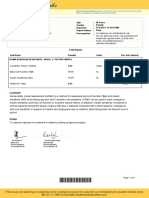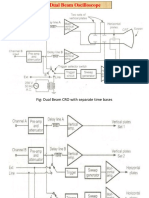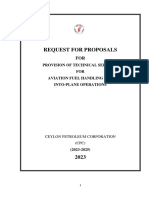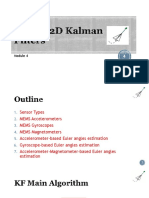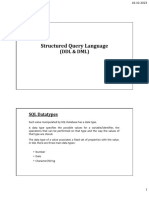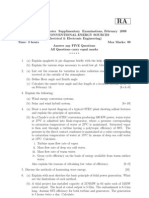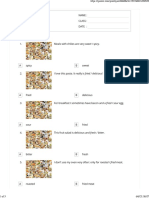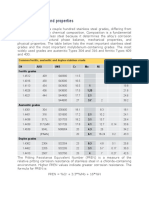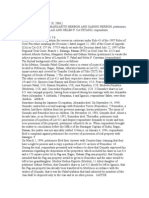Lab01 - Routing Concepts and Static Routing
Lab01 - Routing Concepts and Static Routing
Uploaded by
Pham Van XuanCopyright:
Available Formats
Lab01 - Routing Concepts and Static Routing
Lab01 - Routing Concepts and Static Routing
Uploaded by
Pham Van XuanOriginal Description:
Copyright
Available Formats
Share this document
Did you find this document useful?
Is this content inappropriate?
Copyright:
Available Formats
Lab01 - Routing Concepts and Static Routing
Lab01 - Routing Concepts and Static Routing
Uploaded by
Pham Van XuanCopyright:
Available Formats
UNIVERSITY OF INFORMATION TECHNOLOGY – VNU-HCM
FACULTY OF COMPUTER NETWORKS AND COMMUNICATIONS
1. Routing Concepts and Static Routing
PHỤC VỤ MỤC ĐÍCH GIÁO DỤC
FOR EDUCATIONAL PURPOSE ONLY
A. OVERVIEW
1. Learning objective
The learning objective of this lab is to get familiar with network devices, how they
work together, and the concepts of routing. Moreover, students may practice on
physical networking devices or simulation networking applications such as Cisco
Packet Tracer. This lab will cover the following topics:
1. Introduction to popular networking devices
2. How to configure networking devices
3. The routing concepts and static routing
2. Practice Environment
a) Netacad account
Students need an account at https://www.netacad.com/ to download
necessary resources and use applications released by Cisco. It’s free to create
a new account here.
Lab 1: Routing Concepts and Static Routing
2
b) Cisco Packet Tracer
Packet Tracer is a simulation, visualization, and collaboration tool for learning
networking. It allows students to construct their own model or virtual
networks, obtain access to important graphical representations of those
networks, animate those networks by adding their data packets, and finally
annotate and save their creations.
Download the newest version of Packet Tracer at
https://skillsforall.com/resources/lab-downloads. Furthermore, you may
enroll in the “Getting Started with Cisco Packet Tracer course” at
https://skillsforall.com/topics/cisco-packet-tracer to familiarize yourself with
the usage of the Packet Tracer Tool under the instruction of Cisco Academy.
Faculty of Computer Networks NETWORKS AND SYSTEMS ADMINISTRATION – 09/2022
and Communications luanvt@uit.edu.vn
Lab 1: Routing Concepts and Static Routing
3
B. LAB TASKS
1. Router and routing concepts
Before practice, let’s find the answer to the following questions:
a. What are Routers?
b. What is static routing? Briefly describe the advantages and disadvantages
of static routing.
2. Basic router configuration and static routing
Given the network topology and the IP table
Figure 1: Network topology for Task 2
Device Interface Ipv4 Address Subnet Mask Default
Gateway
R1 G0/0/0 192.168.1.1 255.255.255.252
G0/0/1 192.168.2.1 255.255.255.0
R2 G0/0/0 192.168.1.2 255.255.255.252
G0/0/1 192.168.3.1 255.255.255.0
Faculty of Computer Networks NETWORKS AND SYSTEMS ADMINISTRATION – 09/2022
and Communications luanvt@uit.edu.vn
Lab 1: Routing Concepts and Static Routing
4
PC1 NIC 192.168.2.100 255.255.255.0 192.168.2.1
PC2 NIC 192.168.2.200 255.255.255.0 192.168.2.1
PC3 NIC 192.168.3.50 255.255.255.0 192.168.3.1
Table 1: The IP Address for devices on task 2
Requirements: You are given the network topology as shown in the Figure 1.
1. Building the network topology as
2. Set the hostname for all devices.
3. On Router, set the password uitcisco for the privileged mode, the user
EXEC mode, and Telnet remote access. You should use the encrypted
password for security.
4. Set Banner Motd as “Warning: Authorized Access Only on Router Rx” (Rx is
the name of Router) for all Routes.
5. Assign the IP address for all necessary interfaces of devices.
6. Configuring the static routing in all routers so that all devices can
communicate with each other.
Please note that you should frequently save the Running-configuration to the Startup-
configuration in case of unexpected device rebooting.
3. Subnetting and static routing
Figure 2: Network topology for task 3
Faculty of Computer Networks NETWORKS AND SYSTEMS ADMINISTRATION – 09/2022
and Communications luanvt@uit.edu.vn
Lab 1: Routing Concepts and Static Routing
5
Your company needs to set up the network infrastructure as shown in the topology
in Figure 2. You need to split the network 172.(16+(X%16)).0.0/16 (X is your group
id) into suitable subnets using VLSM (Variable Length Subnet Mask) method.
For example, group 13 will use the network 172.29.0.0/16 for subnetting.
Requirements:
1. Subnetting the given network address for your group and filling the result
in Table 2.
2. Basic configure:
§ Set the hostname for devices.
§ Set the password uitcisco on all routers for privileged EXEC, user
EXEC, and Telnet remote access.
§ Set the Banner motd for all routers: “Warning: Authorized Access Only
on Router X”
3. Assign the IP address to routers’ interfaces. In all LAN zone, the first IP
address of the subnet will assign to the router’s interface, and the others to
PCs or Servers. You need to fill out this information in Table 3
4. All routers need to configure static routing. So that all devices can
communicate with each other.
5. Configure the redundancy route on appropriate routers so that Router 1
and Router 3 can communicate with each other in case the direct link
between Router 1 and Router 3 fails. You can use the floating static route
to achieve this goal.
Note:
§ You should copy Running-configuration to Startup-configuration before
shutdown or close network topology on Packet Tracer Tool to avoid losing
your configuration.
§ Remember to include the topology file (.PKT) in your submission.
Table 2: Subnet information
Subnet Network Address/CIDR First IP Address Broadcast Address
LAN11
LAN12
Faculty of Computer Networks NETWORKS AND SYSTEMS ADMINISTRATION – 09/2022
and Communications luanvt@uit.edu.vn
Lab 1: Routing Concepts and Static Routing
6
LAN21
LAN22
LAN31
LAN32
WAN12
WAN13
WAN23
Table 3: IP Address assignment
Device Interface IP Address Subnet Mask Default Gateway
S0/0/0
S0/0/1
HQ
G0/0
G0/1
S0/0/0
S0/0/1
BR1
G0/0
G0/1
S0/0/0
S0/0/1
BR2
G0/0
G0/1
Faculty of Computer Networks NETWORKS AND SYSTEMS ADMINISTRATION – 09/2022
and Communications luanvt@uit.edu.vn
Lab 1: Routing Concepts and Static Routing
7
PC11
(LAN11)
PC12
(LAN12)
PC21
(LAN21)
PC22
(LAN22)
PC31
(LAN31)
PC32
(LAN32)
Server
(LAN31)
C. REQUIREMENTS
You are expected to complete all tasks in section B (Lab tasks). Advanced tasks
are optional, and you could get bonus points for completing those tasks. We
prefer you work in a team of four to get the highest efficiency.
Your submission must meet the following requirements:
§ You need to submit a detailed lab report in .docx (Word Document) format,
using the report template provided on the UIT Courses website.
§ Either Vietnamese or English report is accepted, that’s up to you. The
report written in the mixing of multiple languages is not allowed (except
for the untranslatable keywords).
Faculty of Computer Networks NETWORKS AND SYSTEMS ADMINISTRATION – 09/2022
and Communications luanvt@uit.edu.vn
Lab 1: Routing Concepts and Static Routing
8
§ When it comes to programming tasks (require you to write an application or
script), please attach all source-code and executable files (if any) in your
submission. Please also list the important code snippets followed by
explanations and screenshots when running your application in your
report. Simply attaching code without any explanation will not receive
points.
§ Submit work you are proud of – don’t be sloppy and lazy!
Your submissions must be your own. You are free to discuss with other
classmates to find the solution. However, copying reports is prohibited,
even if only a part of your report. Both reports of the owner and the copier
will be rejected. Please remember to cite any source of the material
(website, book,…) that influences your solution.
Notice: Combine your lab report and all related files into a single ZIP file (.zip),
name it as follow:
StudentID1_StudentID2_ReportLabX.zip
Faculty of Computer Networks NETWORKS AND SYSTEMS ADMINISTRATION – 09/2022
and Communications luanvt@uit.edu.vn
You might also like
- 3-قاموس المحاسبة طلال ابوغزالةDocument217 pages3-قاموس المحاسبة طلال ابوغزالةMohamed GuerdaneNo ratings yet
- American Safety Technologies MS-880G DK Gray - Part A GHS 139Document8 pagesAmerican Safety Technologies MS-880G DK Gray - Part A GHS 139Muhammad Asyraf Abd HarisNo ratings yet
- Barko Barko Barko Barko Barko Loaders Loaders Loaders Loaders LoadersDocument185 pagesBarko Barko Barko Barko Barko Loaders Loaders Loaders Loaders Loadersalexandre desdoitsNo ratings yet
- Project Possible: Please Support The Developer @Document47 pagesProject Possible: Please Support The Developer @yaloNo ratings yet
- National COVID-19 TERTIARY BURSARY CONFIRMATION LETTERDocument6 pagesNational COVID-19 TERTIARY BURSARY CONFIRMATION LETTERmoshibudi georginaNo ratings yet
- Narayana Techno SchoolDocument4 pagesNarayana Techno SchoolSriram_VNo ratings yet
- Mental Models of The Stock MarketDocument68 pagesMental Models of The Stock Marketnave88No ratings yet
- Abbreviations From Chapter 6 To Chapter 11 PDFDocument60 pagesAbbreviations From Chapter 6 To Chapter 11 PDFArshiya NoorjahanNo ratings yet
- 3863121692023-03-22T11 42 59.407Document6 pages3863121692023-03-22T11 42 59.407Nandini MudigondaNo ratings yet
- ProjectDocument20 pagesProjectHIMANSHU GOELNo ratings yet
- A Brief Review On Piezoelectric PVDF Nanofibers Prepared by ElectrospinningDocument13 pagesA Brief Review On Piezoelectric PVDF Nanofibers Prepared by ElectrospinningMuhammad Shafiz DanialNo ratings yet
- Sent: Thursday, December 3, 2020 4:04:48 AM Subject: RE: Re:KCR Placement Account DetailsDocument3 pagesSent: Thursday, December 3, 2020 4:04:48 AM Subject: RE: Re:KCR Placement Account DetailsAJay MJNo ratings yet
- Digital Scale 340368 - A - D - IE - ENDocument47 pagesDigital Scale 340368 - A - D - IE - ENDimitar KirovNo ratings yet
- 7805 Circuit AnalysisDocument25 pages7805 Circuit Analysisgrb2m2z92No ratings yet
- 800 Gigacenter Ordering Guide: April 2017Document28 pages800 Gigacenter Ordering Guide: April 2017Antwan JosephNo ratings yet
- Catalog Wurth MRODocument22 pagesCatalog Wurth MROBillNo ratings yet
- Session1e PTActA ACLDocument4 pagesSession1e PTActA ACLKhông TrânNo ratings yet
- 2 BanksDocument8 pages2 BanksRajni KumariNo ratings yet
- Topic 5: The Preliminary Estimating Method: Edited By: Norhaniza Binti Mohd Noor (Psmza)Document25 pagesTopic 5: The Preliminary Estimating Method: Edited By: Norhaniza Binti Mohd Noor (Psmza)Elyana Syafika100% (1)
- Archt33 - Electrical SystemDocument35 pagesArcht33 - Electrical SystemRoxette Jane SedonioNo ratings yet
- Family PlanningDocument7 pagesFamily PlanningANNIE SHINE MAGSACAYNo ratings yet
- Information Memorandum - The Dunes Cotton TreeDocument17 pagesInformation Memorandum - The Dunes Cotton TreekatrinajamesdesignNo ratings yet
- Portable Air Conditioner Climatiseur Portatif Acondicionador de Aire PortatilDocument38 pagesPortable Air Conditioner Climatiseur Portatif Acondicionador de Aire Portatilantony2288No ratings yet
- Kwiatkowski 2016Document15 pagesKwiatkowski 2016Fadwa MeguenniNo ratings yet
- Screen MediaDocument9 pagesScreen MediaTere NavaNo ratings yet
- Group 4 PROJECT CHARTER (1.1)Document5 pagesGroup 4 PROJECT CHARTER (1.1)Guilbert AuzaNo ratings yet
- Maiden Pharma ValuationDocument24 pagesMaiden Pharma ValuationmohitguptaNo ratings yet
- 1.1-1.4 The Basic Economic ProblemDocument4 pages1.1-1.4 The Basic Economic Problemgrayce limNo ratings yet
- WP contentuploadsMA Handbook 1 1 PDFDocument105 pagesWP contentuploadsMA Handbook 1 1 PDFsarika yadavNo ratings yet
- Honeywell HIH5031Document8 pagesHoneywell HIH5031odavidson117No ratings yet
- Fig: Dual Beam CRO With Separate Time BasesDocument27 pagesFig: Dual Beam CRO With Separate Time BasesYashaswiniNo ratings yet
- Delay Performance Evaluation IEC 61850 in Power Transmission Substations PDFDocument57 pagesDelay Performance Evaluation IEC 61850 in Power Transmission Substations PDFSavvas KatemliadisNo ratings yet
- UnlockedDocument29 pagesUnlockedAman SinghNo ratings yet
- Cell-Autonomous Toxoplasma Killing Program Requires Irgm2 But Not Its Microbe Vacuolar LocalizationDocument15 pagesCell-Autonomous Toxoplasma Killing Program Requires Irgm2 But Not Its Microbe Vacuolar Localizationarakhel diptaNo ratings yet
- SR Ec1 PN1Document36 pagesSR Ec1 PN1Domagoj ZagoracNo ratings yet
- U.S. Food & Drug Administration 10903 New Hampshire Avenue: Silver Spring, MD 20993Document7 pagesU.S. Food & Drug Administration 10903 New Hampshire Avenue: Silver Spring, MD 20993api-237132031No ratings yet
- Solved ISRO Scientist or Engineer Refrigeration & Air-Conditioning 2013 Paper With SolutionsDocument22 pagesSolved ISRO Scientist or Engineer Refrigeration & Air-Conditioning 2013 Paper With SolutionsD Eswar PrasadNo ratings yet
- Kaur 2020Document7 pagesKaur 2020renohe9897No ratings yet
- Request For Proposals: Provision of Technical Services FOR Aviation Fuel Handling and Into-Plane OperationsDocument61 pagesRequest For Proposals: Provision of Technical Services FOR Aviation Fuel Handling and Into-Plane Operationsa769No ratings yet
- NWT UDocument1,836 pagesNWT UAbous228337No ratings yet
- Swap 1200 FM Transmitter - LRDocument5 pagesSwap 1200 FM Transmitter - LRGenaro ALVAN VASQUEZ0% (1)
- 26.romulo Mabanta v. Home Development Mutual FundDocument8 pages26.romulo Mabanta v. Home Development Mutual FundSeonoNo ratings yet
- User's Manual: GB NL F E D IDocument21 pagesUser's Manual: GB NL F E D IFlorea NicolaeNo ratings yet
- Unit 3Document9 pagesUnit 3AjmalNo ratings yet
- eXP Manual eXP V1.5 202006 ENDocument118 pageseXP Manual eXP V1.5 202006 ENAzar PierreNo ratings yet
- Medius Technologies - Technical Round WADocument15 pagesMedius Technologies - Technical Round WAJaya BhatiaNo ratings yet
- Condition of ReportingDocument1 pageCondition of ReportingPlatoNo ratings yet
- Bedienungsanleitung Strong SRT 7505Document37 pagesBedienungsanleitung Strong SRT 7505Bejan OvidiuNo ratings yet
- Каталог Gedore 2012 EN PDFDocument692 pagesКаталог Gedore 2012 EN PDFСергей ЧабанNo ratings yet
- On Screen Writing BookDocument61 pagesOn Screen Writing BookDada DadaNo ratings yet
- Epidemiology of Anterior Cruciate Ligament Injury in Italian First Division Soccer PlayersDocument10 pagesEpidemiology of Anterior Cruciate Ligament Injury in Italian First Division Soccer PlayersVeronica LopezNo ratings yet
- Cloth Bedding Bed Mattress: IsletaDocument15 pagesCloth Bedding Bed Mattress: IsletaBrian GeronimoNo ratings yet
- 01-06 Interface Management Commands PDFDocument68 pages01-06 Interface Management Commands PDFalan smithNo ratings yet
- Sdjbkssjovsnf HSFJBFDJKDocument5 pagesSdjbkssjovsnf HSFJBFDJKMeita RamaputriNo ratings yet
- Application of The SAW Method in Support Systems Decisions On Providing Assistance To Market TradersDocument10 pagesApplication of The SAW Method in Support Systems Decisions On Providing Assistance To Market TradersMas ZNo ratings yet
- Stainless Steel Square Pipe Price ListDocument7 pagesStainless Steel Square Pipe Price ListKamlendra SinghNo ratings yet
- Falaknuma Exp Third Ac (3A)Document2 pagesFalaknuma Exp Third Ac (3A)Abhaya Kumar NayakNo ratings yet
- Microbio Fuel Cell 2Document2 pagesMicrobio Fuel Cell 2coding727treeNo ratings yet
- Lab01 - Network Devices and Static RoutingDocument8 pagesLab01 - Network Devices and Static RoutingHưng ThụyNo ratings yet
- Lab Manual: III Year/V Sem B.Tech Regulation: 2015 Sub. Code & Sub. Title: 15IT303J - Computer Networks LabDocument84 pagesLab Manual: III Year/V Sem B.Tech Regulation: 2015 Sub. Code & Sub. Title: 15IT303J - Computer Networks LabGandharavaNo ratings yet
- 201 0722 QPDocument4 pages201 0722 QPAsyiqin MohdNo ratings yet
- Module 4 - 1D Kalman Filters For OrientationDocument24 pagesModule 4 - 1D Kalman Filters For OrientationYonas GhiwotNo ratings yet
- Table Creation and DML CommandsDocument26 pagesTable Creation and DML CommandsBighnesh worldNo ratings yet
- In Gov cbse-SSCER-201198572024Document1 pageIn Gov cbse-SSCER-201198572024createart987No ratings yet
- GB - Fire Protective Spray Materials - 24062011Document24 pagesGB - Fire Protective Spray Materials - 24062011Wahed Mn Elnas100% (1)
- Risk Management: Sub: Bca-401 Unit 11Document18 pagesRisk Management: Sub: Bca-401 Unit 11Viyan SinghNo ratings yet
- Ra410202 Non Conventional Energy Sources Set1Document2 pagesRa410202 Non Conventional Energy Sources Set1Srinivasa Rao G100% (1)
- Business Policies & Strategic Management: SR - No Description Option1 Option2 Option3 Option4 ADocument19 pagesBusiness Policies & Strategic Management: SR - No Description Option1 Option2 Option3 Option4 AKrish KrishNo ratings yet
- Evolve 2 Unit - 7 Quiz - 2Document3 pagesEvolve 2 Unit - 7 Quiz - 2Abderrahim Fatmi33% (3)
- TDS - Finawax C 2Document1 pageTDS - Finawax C 2jerome.ecobatchNo ratings yet
- Maza Vs Sec GonzalesDocument4 pagesMaza Vs Sec GonzalesJames LanzarNo ratings yet
- Transmitter and Smart TransmitterDocument57 pagesTransmitter and Smart TransmitterBHAGSEN PARVATNo ratings yet
- Bank Al HabibDocument4 pagesBank Al HabibShahbaz MalikNo ratings yet
- ANN - Perceptron - AdalineDocument15 pagesANN - Perceptron - AdalineDhanushMKuberNo ratings yet
- PR-Request FormDocument2 pagesPR-Request FormVajid MadathilNo ratings yet
- 5.3 Social Impacts of The Industrial RevolutionDocument36 pages5.3 Social Impacts of The Industrial RevolutionMissDang100% (2)
- Adv Planner WebDocument144 pagesAdv Planner Webeduardonunes100% (1)
- Ahro 0135913 PDFDocument1 pageAhro 0135913 PDFValentina ChiticNo ratings yet
- Your Electronic Ticket Receipt - 2024-07-08T144003.577Document2 pagesYour Electronic Ticket Receipt - 2024-07-08T144003.577Vitalidad dNo ratings yet
- Overall Economic Condition of BangladeshDocument14 pagesOverall Economic Condition of BangladeshNishat ShamaNo ratings yet
- Integrated Goods and Service Tax (IGST)Document21 pagesIntegrated Goods and Service Tax (IGST)Avinash As AviNo ratings yet
- Accident Investigation Report - XDocument6 pagesAccident Investigation Report - XCraig HendersonNo ratings yet
- PHA Contact Report WADocument8 pagesPHA Contact Report WAdarkchipmunk668No ratings yet
- Perancangan Kapal Bulk Carrier 9.000 DWT Kecepatan 12 Knot Dengan Rute Pelabuhan Yos Sudarso - Pelabuhan Soekarno-HattaDocument21 pagesPerancangan Kapal Bulk Carrier 9.000 DWT Kecepatan 12 Knot Dengan Rute Pelabuhan Yos Sudarso - Pelabuhan Soekarno-HattaasrunNo ratings yet
- 06 Herbon V Palad and CayetanoDocument8 pages06 Herbon V Palad and CayetanoJed MendozaNo ratings yet
- Ovwmp IGC0 LXF SVYubzo EDocument6 pagesOvwmp IGC0 LXF SVYubzo ESamarth KhatorNo ratings yet
- Infection Prevention and Control Policies and Guidelines For Health Care ServicesDocument324 pagesInfection Prevention and Control Policies and Guidelines For Health Care ServicesAlejandro Caballero ChumillasNo ratings yet
- Cable Tray CertificateDocument1 pageCable Tray CertificatePritam MitraNo ratings yet
- Neuroeconomics Decision Making and The BrainDocument9 pagesNeuroeconomics Decision Making and The BrainOTTO VEGA VEGANo ratings yet
- 0265 03 PDFDocument218 pages0265 03 PDFThiagoPinheiroNo ratings yet








